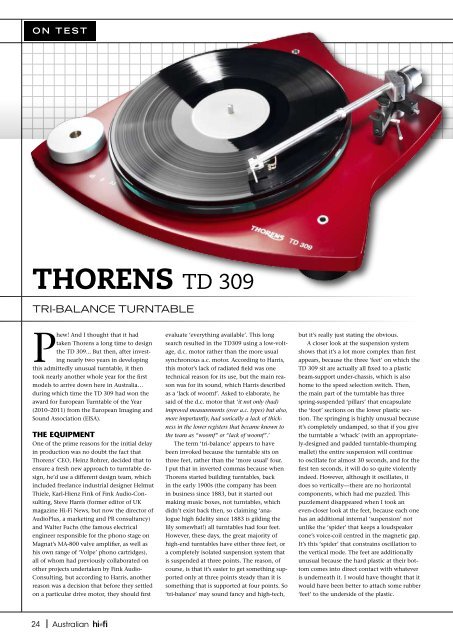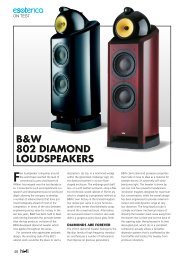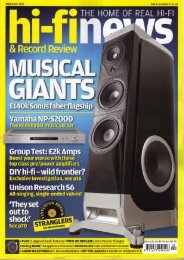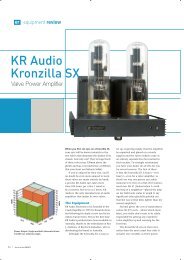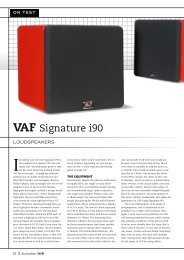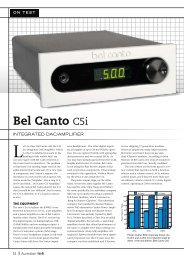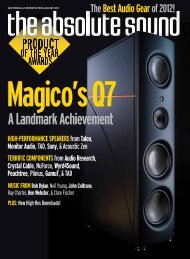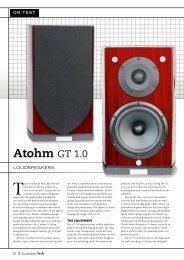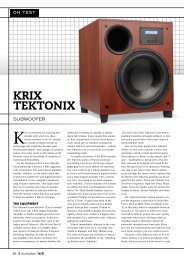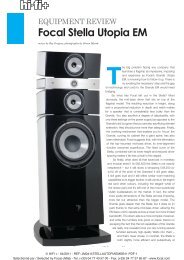THORENS TD 309 - Ultra High-End Audio and Home Theater Review
THORENS TD 309 - Ultra High-End Audio and Home Theater Review
THORENS TD 309 - Ultra High-End Audio and Home Theater Review
You also want an ePaper? Increase the reach of your titles
YUMPU automatically turns print PDFs into web optimized ePapers that Google loves.
O N T E S T<strong>THORENS</strong> <strong>TD</strong> <strong>309</strong>TRI-BALANCE TURNTABLEPhew! And I thought that it hadtaken Thorens a long time to designthe <strong>TD</strong> <strong>309</strong>... But then, after investingnearly two years in developingthis admittedly unusual turntable, it thentook nearly another whole year for the firstmodels to arrive down here in Australia…during which time the <strong>TD</strong> <strong>309</strong> had won theaward for European Turntable of the Year(2010–2011) from the European Imaging <strong>and</strong>Sound Association (EISA).The EquipmentOne of the prime reasons for the initial delayin production was no doubt the fact thatThorens’ CEO, Heinz Rohrer, decided that toensure a fresh new approach to turntable design,he’d use a different design team, whichincluded freelance industrial designer HelmutThiele, Karl-Hienz Fink of Fink <strong>Audio</strong>-Consulting,Steve Harris (former editor of UKmagazine Hi-Fi News, but now the director of<strong>Audio</strong>Plus, a marketing <strong>and</strong> PR consultancy)<strong>and</strong> Walter Fuchs (the famous electricalengineer responsible for the phono stage onMagnat’s MA-800 valve amplifier, as well ashis own range of ‘Volpe’ phono cartridges),all of whom had previously collaborated onother projects undertaken by Fink <strong>Audio</strong>-Consulting, but according to Harris, anotherreason was a decision that before they settledon a particular drive motor, they should firstevaluate ‘everything available’. This longsearch resulted in the <strong>TD</strong><strong>309</strong> using a low-voltage,d.c. motor rather than the more usualsynchronous a.c. motor. According to Harris,this motor’s lack of radiated field was onetechnical reason for its use, but the main reasonwas for its sound, which Harris describedas a ‘lack of woomf’. Asked to elaborate, hesaid of the d.c. motor that ‘it not only (had)improved measurements (over a.c. types) but also,more importantly, had sonically a lack of thicknessin the lower registers that became known tothe team as “woomf” or “lack of woomf”.’The term ‘tri-balance’ appears to havebeen invoked because the turntable sits onthree feet, rather than the ‘more usual’ four.I put that in inverted commas because whenThorens started building turntables, backin the early 1900s (the company has beenin business since 1883, but it started outmaking music boxes, not turntables, whichdidn’t exist back then, so claiming ‘analoguehigh fidelity since 1883 is gilding thelily somewhat!) all turntables had four feet.However, these days, the great majority ofhigh-end turntables have either three feet, ora completely isolated suspension system thatis suspended at three points. The reason, ofcourse, is that it’s easier to get something supportedonly at three points steady than it issomething that is supported at four points. So‘tri-balance’ may sound fancy <strong>and</strong> high-tech,but it’s really just stating the obvious.A closer look at the suspension systemshows that it’s a lot more complex than firstappears, because the three ‘feet’ on which the<strong>TD</strong> <strong>309</strong> sit are actually all fixed to a plasticbeam-support under-chassis, which is alsohome to the speed selection switch. Then,the main part of the turntable has threespring-suspended ‘pillars’ that encapsulatethe ‘foot’ sections on the lower plastic section.The springing is highly unusual becauseit’s completely undamped, so that if you givethe turntable a ‘whack’ (with an appropriately-designed<strong>and</strong> padded turntable-thumpingmallet) the entire suspension will continueto oscillate for almost 30 seconds, <strong>and</strong> for thefirst ten seconds, it will do so quite violentlyindeed. However, although it oscillates, itdoes so vertically—there are no horizontalcomponents, which had me puzzled. Thispuzzlement disappeared when I took aneven-closer look at the feet, because each onehas an additional internal ‘suspension’ notunlike the ‘spider’ that keeps a loudspeakercone’s voice-coil centred in the magnetic gap.It’s this ‘spider’ that constrains oscillation tothe vertical mode. The feet are additionallyunusual because the hard plastic at their bottomcomes into direct contact with whateveris underneath it. I would have thought that itwould have been better to attach some rubber‘feet’ to the underside of the plastic.24 Australian
<strong>THORENS</strong> <strong>TD</strong> <strong>309</strong> TRI-BALANCE TURNTABLEO N T E S THowever, this is just a personal observation—as with all mechanical systems, the proof isultimately in how well the feet perform theirintended function.The motor is supported in a cut-out inthe main part of the plinth first by a plastic‘insert’ that positions the motor off-centrein the cut-out <strong>and</strong> then by another ‘spider’suspension. (It probably won’t come as asurprise that Karl-Hienz Fink is a well-knownspeaker designer!) The reason for the off-centreplacement of the motor is sheer genius. Byrotating the plastic insert (after first releasinga locking screw) you can apply tensionto the belt, so that as the belt stretches withincreased use, you can compensate for theslightly looser fit by rotating the motor assemblyto restore the original tension. It’sso simple… <strong>and</strong> yet so clever. Once properlytensioned, the flat belt (it’s 4mm wide,496mm long <strong>and</strong> ground to a toleranceof 0.03 microns) maintains the same patharound the motor pulley <strong>and</strong> the aluminiumsub-platter assembly, so speed selection isnecessarily electronic. You can select between33.33rpm <strong>and</strong> 45 rpm, with an ‘off’ positionmidway between. The sub-platter sits on aninverted spindle-<strong>and</strong>-bearing for which thetolerances are ultra-tight—the engineering issuperb.The main platter, which sits on a raisedring at a diameter of 121mm on the aluminiumsubplatter, (this particular diameterselected by finite element analysis to be atthe lowest resonant point of the subplatter)is made from what looks like frosted glass(<strong>and</strong> in fact most reviewers say that it’s glassin their reviews), but according to Thorens,the platter is actually made from fused silica.Fused silica has a great number of highlydesirable properties, which include near-zerothermal expansion, low dielectric constant,low dielectric loss, that it can be lapped <strong>and</strong>polished to fine finishes (as it is here) <strong>and</strong>that it’s almost completely chemically inert.(Pedants might argue that fused silica is still aglass, because it’s technically a noncrystallineform of silicon dioxide (quartz, s<strong>and</strong>) <strong>and</strong>long-range order in its atomic structure.) Toensure the main platter sits perfectly over thesubplatter, Thorens has formed a fairly largehole in the centre of the platter, then fitted asmaller black plastic internal sleeve to makethe link between the fused silica platter <strong>and</strong>the central spindle. The tolerances on thistiny plastic moulding are also excellent. Theonly way I was able to ‘improve’ on the fitwas with a tiny ‘shim’ made from ultra-thinrice paper, but this ‘tweak’ proved ultimatelyfutile, since I couldn’t hear any discernabledifference in the sound with or without theshim.I had never seen the particular tonearmused on the <strong>TD</strong><strong>309</strong> before, which was abreath of fresh air. I am getting a little tiredof unpacking new turntables which aresupposedly fitted with ‘new’ or ‘proprietary’tonearms only to discover that the tonearmis actually just a slightly modified, re-badged,tonearm made by another manufacturer thatcan be found as st<strong>and</strong>ard fitment on a dozenother turntables. The Thorens TP 92 arm ISnew, <strong>and</strong> was designed by Fink <strong>Audio</strong>-Consulting.The tubular aluminium arm tubeis cold worked <strong>and</strong> rolled for strength, <strong>and</strong>then its surface is coated with a materialthat damps resonances that would otherwiseappear in an identical, but undamped,tonearm. The arm allows you to adjust VTA<strong>and</strong> azimuth angle (rather fiddly to do, butat least you can do it!). Anti-skating adjustmentis accomplished magnetically, rather byeither a spring or a string-<strong>and</strong>-weight system.The arm’s high-precision bearings are madefor Thorens in Japan. The unique headshellmounts to the cartridge <strong>and</strong> arm tubeseparately, which makes cartridge mountingvery easy, but also allows 5mm of overhangadjustment. (If you want more, you can ekean additional 6mm of overhang from thebearing end of the tonearm.)Speaking of the tonearm, Thorens providesa large metal forging that looks like arecord spindle weight but isn’t: it’s intendedto balance the weight of the tonearm. Thisseemed odd to me, for several reasons. Firstly,the weight seemed heavier than the armcould possibly be, though I suspect one hasto take the moment into account (the tonearmmount being further away from the centralpoint than the weight) but also becausesince the turntable comes st<strong>and</strong>ard with theturntable, it would have made more sense (atleast to me) to have incorporated the extraweight into the plinth. However there’s achance that, while it does ‘balance out’ thetonearm, it also serves some other purposethat Thorens does not wish to reveal.I should make a note about the packagingused to ship the turntable, because I wasn’tentirely happy with it. The outer cardboardcarton is not particularly robust <strong>and</strong> inside,in line with European laws, there’s no polystyrene,so all ‘padding’ is provided by foldedsections of cardboard, <strong>and</strong> on my sample,the cardboard had shifted <strong>and</strong> dislodged theheadshell on the supplied phono cartridge.I am all for being green, but surely Thorenscould apply for exemptions to packaging lawsto allow it to use materials more suitable forprotecting such fragile components as phonocartridges, thin-wall aluminium tonearms<strong>and</strong> fused silica platters?Listening SessionsEven though three feet describe a plane, sothat the <strong>TD</strong> <strong>309</strong> can never ‘rock’ on its feet ifthe surface on which it is placed is uneven,you still have to level the turntable if what-<strong>THORENS</strong> <strong>TD</strong> <strong>309</strong>TRI-BALANCE TURNTABLEBr<strong>and</strong>: ThorensModel: <strong>TD</strong> <strong>309</strong>Category: TurntableRRP: $2,499Warranty: Two YearsDistributor: Speakerbits Pty LtdAddress: Unit F51 63 Turner StreetPort Melbourne VIC 3207(03) 9647 7000(03) 9681 8207sales@speakerbits.comwww.speakerbits.com• Speed accuracy• Lack of rumble• Low wow <strong>and</strong>flutter• Dustcover• Feet levelling• Tonearmadjustmentsavhub.com.au25
O N T E S T<strong>THORENS</strong> <strong>TD</strong> <strong>309</strong> TRI-BALANCE TURNTABLEever you’ve put it on is not absolutely levelitself (<strong>and</strong> remember, even if a support tableis perfectly symmetrical, it may be your floorthat’s not level. I once lived in a house wherethe floor dropped at 1cm per metre, fromthe front of the house to the back, so in afive-metre run through the kitchen, the floordropped five centimetres! (This meant thekitchen bench was five centimetres higher atone end than the other, which turned out tobe great, because it then accommodated shortcooks at one end, <strong>and</strong> tall ones at the other!)If the surface on which you place the <strong>TD</strong><strong>309</strong> is not level, DO NOT use an Allen-keyto try to adjust the feet, this is not what thescrew adjustments (accessed through holes inthe top of the turntable) are for. Instead, thescrews adjust spring tension inside the feet,<strong>and</strong> this needs to be identical for each foot,so if you wind one out to make the foot ‘longer’you’ll upset the balance of the turntable.If you need to lift one or more of the feet toget the platter level, you’ll just have to putshims under the feet or… better still, correctthe level of the surface on which the <strong>TD</strong> <strong>309</strong>is sitting. Apparently, according to Thorens,the primary reason it’s adjustable is so thataudiophiles who add a significant weight tothe turntable, in the form of a record clamp,or special platter mat, or even a dust cover ofsome type (because, the <strong>TD</strong> <strong>309</strong> doesn’t comewith a dust cover, not least because its unusualshape would mean a very oddly-shapeddustcover, that couldn’t be hinged), you canadjust the spring tension accordingly. (Apparently,there should be a 1mm ‘gap’ visible justabove the bottom-most section of the foot.)Another thing you should NOT do is tryto move the ‘damper’ ring that’s approximatelyin the centre of the tonearm tube.Apparently, Fink <strong>Audio</strong>-Consulting spent aconsiderable amount of time with a scanninglaser vibrometer to determine the optimumlocation for this damper (technically, it’scalled a compliant mass absorber), so unlessyou happen to have a scanning laser interferometerh<strong>and</strong>y, I’d recommend leaving it wellalone. While I am mentioning the arm, it hasan unusual feature: an additional ‘ground’wire. According to Fink <strong>Audio</strong>-Consulting,this ‘prevents any current flowing through thetonearm bearings.’ You can see the wiring here:[http://tinyurl.com/<strong>TD</strong><strong>309</strong>]I have mentioned the lack of a turntabledust cover. I’d really suggest you try to organisesome type of cover for two reasons. Oneis simply to stop dust collecting on your LPswhile you’re playing them. As it is, wheneveryou play an LP on the <strong>TD</strong> <strong>309</strong>, you’lleffectively be leaving its surface exposed tothe atmosphere for 20 to 30 minutes perside—plenty of time for dust to accumulate.Another useful reason for having a dustcoveris that it reduces the level of airbornesound energy reaching the record surface<strong>and</strong> cartridge… especially if you play at highsound pressure levels. Because of the shapeof the <strong>TD</strong> <strong>309</strong>, if you were to organise yourown dustcover, I’d get one that goes over theentire turntable, so its edges rest on whateversurface the turntable is sitting on. This meansit would be easy to use <strong>and</strong> would not affectthe operation or performance of the <strong>TD</strong> <strong>309</strong>in any way. And if you left it over the <strong>TD</strong> <strong>309</strong>when you’re not using it, it would itself becompletely protected from dust <strong>and</strong> potentialdamage.With so many people buying turntables atleast partly for the purpose of ‘digitising’ anexisting LP collection (that is, transferring alltheir old LPs to electronic files… WAV, MP3,FLAC or whatever, Heinz Rohrer conceivedthe <strong>TD</strong> <strong>309</strong> as a ‘plug ‘n play’ turntable,able to be used straight out of the box byusers who were not necessarily audiophiles,interested (<strong>and</strong> experienced!) in the arcanaof turntable setup <strong>and</strong> cartridge/tonearmalignment. To expedite this, the <strong>TD</strong> <strong>309</strong>comes pre-fitted with a budget ‘AT-95B’ moving-magnetcartridge. There was no br<strong>and</strong>ingon my sample, <strong>and</strong> Thorens doesn’t actuallymention the br<strong>and</strong> in its manual, but it’smade by <strong>Audio</strong> Technica, <strong>and</strong> is very similarto that company’s AT-95E which has receivedseveral ‘Best Buy’ ratings in the UK. Perhapsmost significantly, this particular <strong>Audio</strong>-Technica body is said to be the ‘mould’ forthe highly acclaimed Linn Basik, K5 <strong>and</strong> K9phono cartridges.Rohrer’s innovative move has met withsome flak from hi-fi reviewers in Germanywho, to a man (there were no women!), saythe <strong>TD</strong> <strong>309</strong>’s performance is more deservingof a higher-quality cartridge. This mayvery well be true—in fact in my opinion itIS true!—but I think they’ve missed Rohrer’svery valid point. For many buyers, the<strong>TD</strong> <strong>309</strong> will already be the most expensiveturntable they’ve ever purchased, <strong>and</strong> theywouldn’t be too pleased if they suddenly discoveredthey had to spend another thous<strong>and</strong>dollars or so on a phono cartridge, $170 ona down-force gauge <strong>and</strong> between $199 <strong>and</strong>$425 on a cartridge alignment tool (the pricesfor the Align-It <strong>and</strong> Clear<strong>Audio</strong> respectively,which are the best available cartridge alignmenttools on the market), <strong>and</strong> then spendseveral hours learning how to install <strong>and</strong>align their new purchase. Thanks to Rohrer’sinitiative, non-audiophile users can betransferring LPs to their hard drives (or justlistening to music!) just ten minutes afteropening the box.But what of the sound of the <strong>Audio</strong>Technica cartridge? While I am sure thisopinion will outrage some readers, I’d haveto say that I thought the sound quality waspretty damn good!… sure the extreme highsaren’t totally transparent, <strong>and</strong> there’s a tiny,tiny suck-out in the upper midrange, but theoverall frequency response is extended (<strong>and</strong>is particularly solid in the bass) <strong>and</strong> certainlyentirely balanced, <strong>and</strong> the stereo imagingis excellent—almost as good as I’ve heardeven from some of the very best high-endphono cartridges. Tracking ability was fairlyordinary, in that it had difficulty with someof my ‘over-the-top’ audiophile pressings(from Sheffield etc), but it was good enoughthat the cartridge had no difficulty tracingthe grooves of all the commercial pressings Itried, even to the extent of absolutely sailingthrough both Emerson Lake <strong>and</strong> Palmer’sfirst, self-titled album, <strong>and</strong> their second,Tarkus, which are notable for being engineeredwith far more bass energy than mostordinary phono cartridges can h<strong>and</strong>le. (Thefirst ELP album is a tour-de-force, not leastbecause of the individual musicianship of theb<strong>and</strong> members—particularly Keith Emerson—but also because two of the tracks (Barbarian<strong>and</strong> Knife Edge) were at least partly writtenby those famous rock musicians Béla Bartók,Leoš Janácek <strong>and</strong> Johann Sebastian Bach.26 Australian
O N T E S T<strong>THORENS</strong> <strong>TD</strong> <strong>309</strong> TRI-BALANCE TURNTABLE(For confused readers, Barbarian is a reworkingof Bartóks’ Allegro Barbaro <strong>and</strong> KnifeEdge sounds a lot like a melding of the firstmovement of Janácek’s Sinfonietta with theallem<strong>and</strong>e from Bach’s French Suite in D minor,BWV 812.)So if I purchased the <strong>TD</strong> <strong>309</strong>, I certainlywould not be ripping out the <strong>Audio</strong> Technicacartridge that comes with it any time realsoon. I would instead enjoy what is essentiallya ‘freebie’ from Thorens, <strong>and</strong> use it torip my vinyl to electronic files, <strong>and</strong> spend myspare moments imagining which movingcoilcartridge I’d eventually get around toreplacing it with some time down the track.One minor grievance here is that because ofthe unusual tonearm design, you can’t easilyplug different cartridges in <strong>and</strong> out of thetonearm, so it would be largely impractical(although certainly possible!), for example, touse a budget cartridge to play your scratched<strong>and</strong> damaged LPs <strong>and</strong> reserve an expensivehigh-end cartridge for your more pristinealbums. Still, few high-end tonearms thesedays have plug-in headshells that wouldallow this, so it could hardly be levelled as acriticism when talking about the <strong>TD</strong> <strong>309</strong>.The performance of the <strong>Audio</strong> Technicawas certainly more than sufficient to allowme to completely evaluate all aspects of the<strong>TD</strong> <strong>309</strong>’s performance because all of themost important turntable attributes do notdepend on a cartridge’s technical ability orsound quality at all. Take speed accuracy, forexample. You can determine whether or nota platter is rotating at the correct speed byusing a strobe card. If you don’t already haveone, there’s a free one available here: [www.avhub.com.au/images/stories/pdf/strobe.pdf] My card showed the platter was rotatingslightly fast at both 33.33rpm <strong>and</strong> 45rpm, soI had to adjust the speed using the two tinyscrew adjusters located to the left (for 33.33)<strong>and</strong> right (for 45) of the speed switch tofine-tune it. Rather confusingly, I found thatturning the grub screws clockwise actually decreasesspeed, whereas I would have expectedthe opposite to be the more natural directionto do this! Also, while making these adjustments,I discovered that adjusting one speedhas a tiny effect on the speed of the other, soeventually I settled on getting the 33.33 rpmspeed as accurate as I could <strong>and</strong> settling forthe 45 being slightly fast. Newport Test Labslater reported that even after my optimal setting,circuit drift (<strong>and</strong> perhaps the shippingover to the lab?) had subsequently increasedthe platter speed 0.2% fast at 33.33rpm <strong>and</strong>0.3% fast at 45rpm, which they reset beforetesting. As you can tell from the percentagesthis is a very tiny error indeed—so tiny thateven someone with perfect pitch would beunable to hear the difference—assuming thatthe recording that was being replayed wasactually recorded at the correct speed in thefirst place (a great many LPs are not), so Iwouldn’t be overly concerned about trying tokeep the platter speed exact: even turntableswith a.c. synchronous motors can rarelyachieve this!You also don’t need an audiophile cartridgeto hear if a turntable has unwantedlow-speed variations (known as ‘wow’) orhigher-speed variations (‘flutter’). I usedthe usual music to test for both (slow pianomusic… I used Erik Satie, but any slowpiano music would do) <strong>and</strong> can report that Iheard absolutely no wow or flutter whatsoever.(Again, Newport Test Labs measuredlow levels of wow <strong>and</strong> flutter—0.06% RMSunweighted/0.05% CCIR weighted—soalthough you can certainly benchmark theirreported results against some other turntableto see which had the ‘lowest’ levels, the factis that the levels are so low that you won’tbe able to hear any wow <strong>and</strong> flutter effectsat all—they’re below the level of audibility.)If you DO hear some wow <strong>and</strong> flutter, it willbe because the belt is too loose, <strong>and</strong> in thiscase all you have to do is rotate the motor inits sleeve until the belt is just tight enoughthat the wow <strong>and</strong> flutter disappears—but notighter!I also checked for the potential for intermodulationdistortion: not by listening,but by ‘firing’ a laser-beam across the topsurface of the platter while it was rotating.This allows me to check the turntable bearingalignment <strong>and</strong> platter flatness to make surethe platter won’t move the arm up <strong>and</strong> downwhile it’s tracing the record, which wouldcause intermodulation distortion (IMD). The<strong>TD</strong> <strong>309</strong> performed brilliantly in this test: thebearing, bearing location <strong>and</strong> the surface aresuperb!Unwanted low-frequency noise (the infamous‘rumble’) is the bête noire of turntabledesign, whether it issues from the motorthat’s driving the platter, or the rotation ofthe platter bearing itself. It’s also extraordinarilydifficult to discern the contributionfrom the turntable itself, because all records,even audiophile pressings, contain unwantedlow-frequency noise… usually caused bythe recording lathe. Because of this, I checkfor rumble using acetate (not vinyl) mastersspecially cut for the purpose, using a filterto remove high-frequency ‘surface’ noisecaused by the stylus travel. Using this set-upI couldn’t hear any rumble at all, even whenI turned the volume up to well above normalplayback levels. As a result of this, I can confidentlysay you won’t hear any low-frequencynoise caused by the <strong>TD</strong> <strong>309</strong> when playingback your LPs, irrespective of whether they’resuper-quiet audiophile pressings or normalcommercial ones.Turntable isolation (how well it rejectsair-borne <strong>and</strong>/or surface-borne vibrations)is so difficult to consistently <strong>and</strong> reliablyevaluate (the old ‘thump the desk alongsidethe turntable while an LP is playing’ testdoesn’t really cut it) that I hesitate to be tooprescriptive about the performance of the <strong>TD</strong><strong>309</strong>. Overall, however, I’d say that it returned‘better than average’ performance within itsprice class (talking absolutes, Clearaudio’sStatement turntable clearly outperforms it!).ConclusionThe <strong>TD</strong> <strong>309</strong> is a breath of fresh air fromThorens. This stylish new design is undoubtedlyamongst the best-performing turntablesThorens has ever manufactured, <strong>and</strong> iscertainly fitted with one of its best arms ever,yet its asking price is set so far below what I’dhave thought Thorens would ask for it thatI genuinely wonder if it is being sacrificed asa ‘loss leader’ to gain some free publicity forthe company. If this is indeed the case, <strong>and</strong>you like the look <strong>and</strong> sound of the <strong>TD</strong> <strong>309</strong>,I’d suggest you take advantage of the pricewhile you can. And from Thorens’ point ofview, if you’d like a turntable but want somethingthat looks more traditional, or is lowerpriced (or, for that matter, higher-priced), the<strong>TD</strong> <strong>309</strong> has already done its job by gainingThorens some free publicity (not to mentionthat EISA award for ‘Best Turntable’), so as aresult you’re probably more likely than youotherwise might have been to look at thedozens (literally!) of other turntables bearingthe famous Thorens badge…greg borrowman28 Australian


